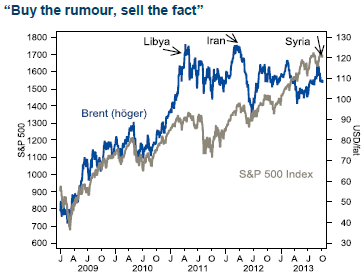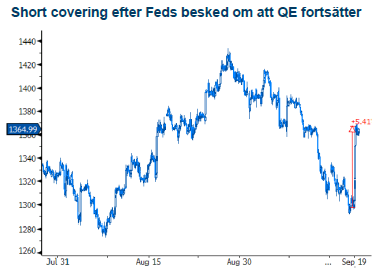Analys
Kvartalsrapport för råvaror

 Råvaruplanket – Egna ben
Råvaruplanket – Egna ben
Låga förväntningar skapar uppsida
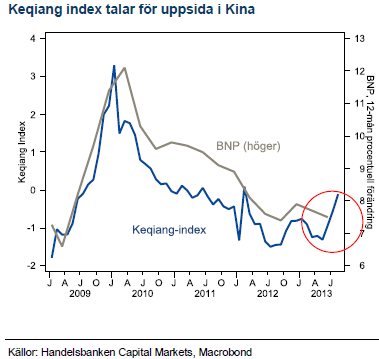 Vi tror att Kina håller på att stå för andra halvårets positiva makroöverraskning. Efter inbromsning och ”svagare än väntat data” under 2012 och H1 13 så pekar nu barometerdata på en vändning i Kina. ”Keqiang index” som består av järnvägstransporter, elproduktion och utlåning talar för att BNP för Q3 kommer överraska på uppsidan. Flera indikatorer talar för en starkare utveckling i början av hösten trots att PMI serierna inte har förutspått denna uppgång i industriaktiviteten. Ökad kreditgivning och till viss del stimulansinvesteringar från de nytillträdda ledarna har vänt vårens kraftiga inbromsning i den kinesiska industrin. Att PMI-serierna inte har pekat uppåt tidigare förklarar vi med den djupt rotade pessimism som spridit sig i industrin efter 2012 års kreditåtstramning och bestående överkapacitet.
Vi tror att Kina håller på att stå för andra halvårets positiva makroöverraskning. Efter inbromsning och ”svagare än väntat data” under 2012 och H1 13 så pekar nu barometerdata på en vändning i Kina. ”Keqiang index” som består av järnvägstransporter, elproduktion och utlåning talar för att BNP för Q3 kommer överraska på uppsidan. Flera indikatorer talar för en starkare utveckling i början av hösten trots att PMI serierna inte har förutspått denna uppgång i industriaktiviteten. Ökad kreditgivning och till viss del stimulansinvesteringar från de nytillträdda ledarna har vänt vårens kraftiga inbromsning i den kinesiska industrin. Att PMI-serierna inte har pekat uppåt tidigare förklarar vi med den djupt rotade pessimism som spridit sig i industrin efter 2012 års kreditåtstramning och bestående överkapacitet.
Växande utbud
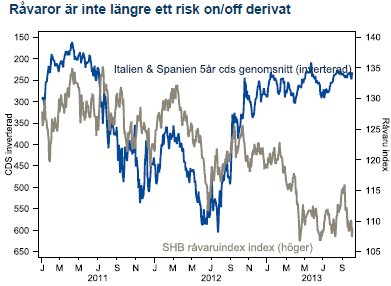 Dämpad global tillväxt och stark tillväxt i utbudet av många råvaror har gjort att prisutvecklingen har varit modest under 2013. Råvaror handlas inte längre som ett risk on/off derivat som under 2011 och 2012 vilket gjort råvaror mindre beroende av makro och mer prissatta utefter varje råvaras fundamenta. Följaktligen har korrelationen mellan aktier och råvaror fallit samtidigt som korrelationen mellan enskilda råvaror också trendat nedåt.
Dämpad global tillväxt och stark tillväxt i utbudet av många råvaror har gjort att prisutvecklingen har varit modest under 2013. Råvaror handlas inte längre som ett risk on/off derivat som under 2011 och 2012 vilket gjort råvaror mindre beroende av makro och mer prissatta utefter varje råvaras fundamenta. Följaktligen har korrelationen mellan aktier och råvaror fallit samtidigt som korrelationen mellan enskilda råvaror också trendat nedåt.
Dollar och normalisering
Under 2011 och 2012 fanns ett starkt samband mellan dollarns värde och råvarornas prisutveckling. Under 2013 har även detta samband varit svagare och vissa råvaror har stärkts kraftigt samtidigt som dollarn har apprecierat. Årets tidvis positiva korrelation mellan råvaror och dollar är ett i raden av tecken på att vi går mot en normalisering av råvarumarknaden. Varje enskild råvaras fundamenta kommer härifrån få större betydelser för prissättningen.
Basmetaller
Tydliga signaler
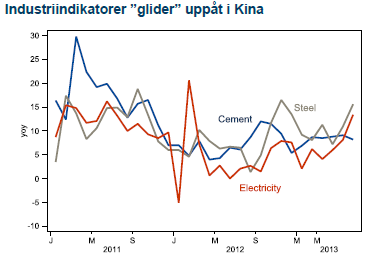 Klara signaler från kinesiska ledare säger att de kommer försvara den lägsta tillåtna tillväxten. Man anar att ledarna oroas av att tillväxten fallit för mycket och för snabbt under H1 2013. Därav har man bromsat reformarbetet något och ökat kreditgivningen för att undvika en hårdlandning.
Klara signaler från kinesiska ledare säger att de kommer försvara den lägsta tillåtna tillväxten. Man anar att ledarna oroas av att tillväxten fallit för mycket och för snabbt under H1 2013. Därav har man bromsat reformarbetet något och ökat kreditgivningen för att undvika en hårdlandning.
Den förväntat starkare utvecklingen under Q4/Q1 ska inte extrapoleras då investeringar fortfarande driver Kinas ekonomi. Ombalanseringen av tillväxten kommer att kosta ytterligare tillväxt och det är enbart en timingfråga när denna ombalansering kommer att accelereras. Det är rimligt att ledarnas ursprungliga plan, att påskynda ombalanseringen under 2013, fick oväntat stark motvind genom svagare exportbidrag från EMU-krisen. Därför sköts den till viss del på framtiden och viss mån av stimulanser ersatte reformpolitiken. Kinas nya ledare signalerar att man använder stimulans för att stabilisera ekonomin, snarare än accelerera den som var fallet för de tidigare ledarna.
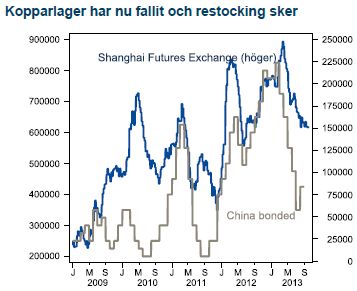 Lagercykeln (igen)
Lagercykeln (igen)
Vi har tidigare pekat på den allt starkare lagercykeln i Kina. Årets produktionsstarkaste kvartal, Q2 och delvis Q3, sänker lager av råvaror som sedan ska fyllas på under slutet av året. Detta år ser inte ut att bli något undantag och importen har redan varit stark under två månader.
Höga förväntningar på utbudet
I förväntningarna på utbudssidan råder nu en stark konsensus att produktionen ska öka, främsta på koppar, under Q4 och 2014. Finansiella aktörer är fortfarande nettokorta koppar trots senaste datavågen från Kina och en eventuell besvikelse i nytillkommen kopparproduktion kan driva priserna kraftigt under slutet av året. Framför allt är det O.T. i Mongoliet och Los Bronces i Chile som står för största delen av årets nytillskott och därmed ökad risk.
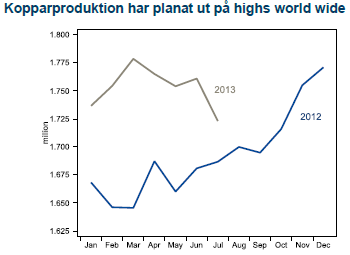 Av basmetallerna har just nu bly den minsta marginalen i marknadsbalansen. Stark bilförsäljning i Kina tillsammans med en svagare trend i gruvproduktionen har fått ner LME-lagren ordentligt under året.
Av basmetallerna har just nu bly den minsta marginalen i marknadsbalansen. Stark bilförsäljning i Kina tillsammans med en svagare trend i gruvproduktionen har fått ner LME-lagren ordentligt under året.
Energi
”Man petar inte på en skallerorm”
Obamas retorik kring inbördeskriget i Syrien drev snabbt upp oljepriset från 100-strecket. Syrien är inget oljeland men den pågående konflikten i Syrien mellan Shia och Sunni har en direkt återspegling i Irak som åter blivit ett viktigt oljeland. Iraks återkomst till exportmarknaden har skett simultant med att Iran föll bort efter sanktionerna förra året. Irak lindrade därmed konsekvenserna av sanktionerna och Irak är viktigt i dagsläget då dess export inte kan kompenseras av Saudis återstående reservkapacitet.
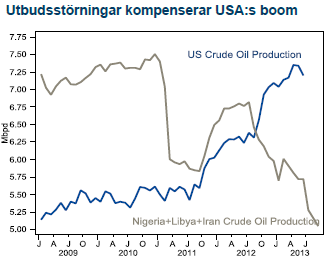 Utbudsdrivna råvarurally ska man sälja…
Utbudsdrivna råvarurally ska man sälja…
När förhoppningarna om en diplomatisk lösning växte fram pyste riskpremien snabbt ur Brentoljan. Händelsen får oss att åter upprepa devisen att sälja utbudsdrivna råvarurally och köpa efterfrågedrivna. Utbudsdrivna rallyn tenderar att vara överdrivna på grund av den stora osäkerheten och brist på information samtidigt som de är tillfälliga till sin natur.
…men efterfrågedrivna ska man köpa
När mycket av riskpremien nu är borta kan man återigen förvänta sig stigande oljepris på mer fundamental grund. Produktionsstörningar på flera håll, och av skilda orsaker, kompenserar för den nytillkomna oljeproduktionen i USA. Nigeria, Libyen och Iran ser alla ut att vara långvariga störningar medan Irak kan bli en sådan. Samtidigt gör den globala konjunkturförbättringen sitt för att stärka efterfrågan.
Mycket rönnbär ger kall vinter…
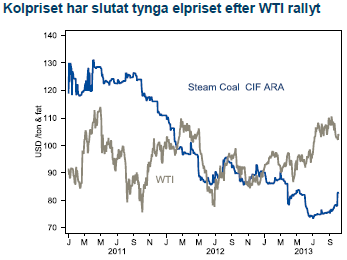 Vår tro på stigande elpriser under hösten har besannats men från lägre nivåer än vi först anande. Stigande olje- och gasproduktion i USA leder till ökad export av kol från USA till Europa vilket har tryckt ner kolpriset till oanade nivåer. Efter att WTI-oljan nu klättrat så har prisfallet på kol planat ut och gett stöd åt ett elrally i Norden.
Vår tro på stigande elpriser under hösten har besannats men från lägre nivåer än vi först anande. Stigande olje- och gasproduktion i USA leder till ökad export av kol från USA till Europa vilket har tryckt ner kolpriset till oanade nivåer. Efter att WTI-oljan nu klättrat så har prisfallet på kol planat ut och gett stöd åt ett elrally i Norden.
Den kallare perioden ökar riskerna med högre efterfrågan vilket leder till att kärnkraftens relativa betydelse växer. I år går vi in i kylan med ett underskott i vattenmagasinen och Sveriges äldsta reaktor Oskarshamn 1 är stängd till april 2014. Således finns risk på uppsidan, men väder- och teknikgudarna avgör utfallet.
Ädelmetaller
Slutet på QE
Vår syn på guld som en metall vars långa trend går nedåt ligger fast. Efter att de kortsiktiga positiva effekterna från en Amerikansk attack på Syrien och Feds uteblivna nedskalning av QE så tror vi åter att guldet kommer vända nedåt. En starkare amerikansk ekonomi, högre USA-räntor, låg inflation samt att Fed ska skala ner QE är alla argument för lägre guldpriser. Fed överraskade när man inte började skala ner obligations-köparprogrammen den 19:e sep. Främsta skälet är oro för finanspolitiken samt åtstramning i de finansiella förhållandena. Nedskalning kan nu bli aktuellt senare i år, men nu är det svårt att veta vad som ska prisas då Fed börjat sväva på målet. Minskat stöd till marknaden ska, allt annat lika sänka inflationsförväntningarna och stärka USD, båda faktorerna är negativa för guldpriset.
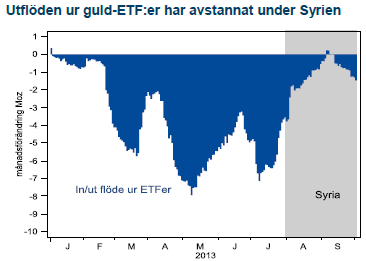 Silvrets volatilitet består
Silvrets volatilitet består
Silver har åter visat hur volatil marknaden kan vara. Rallyt i augusti var väldigt starkt med en uppgång på 31 % under tre veckor. Därmed återtogs mer än halva vårens ras. Mycket av rallyt får nog tillskrivas många korta positioner som stoppades ut. Så länge silvermarknaden befinner sig i överskott kommer de finansiella influenserna att vara starkare än de industriella, trots att silvrets industriella användning är mycket större än guldets.
 Läget för platinaindustrin är utmanande
Läget för platinaindustrin är utmanande
Vi fortsätter att se stark fundamenta för palladium och platina. Den osäkra produktionssituationen med en stor del av produktionen koncentrerad till Sydafrika i kombination med stor exponering mot fordonsindustrin på efterfrågesidan ger en grogrund för högre priser. Upproren i Sydafrikas gruvor har inte lett till någon utbredd strejk men sporadiskt våld förekommer och läget är nervöst bland fackföreningarna. Den lägre sydafrikanska randen har hjälpt de ekonomiskt utsatta gruvbolagen. För att långsiktigt öka produktionen i takt med Asiens växande fordonsflotta kommer det krävas högre priser.
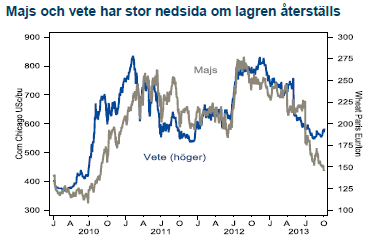 Jordbruk
Jordbruk
Utsikterna inte längre tiltade
Vårt starkaste tema under 2013 har varit fallande priser på soja, majs och vete när produktionen återhämtas under det nya odlingsåret. Priserna på majs och vete har också fallit med omkring 20 % detta år. Nu är dock inte bilden entydig längre. Förväntansbilden har slutligen justerats så att produktionsrapporterna inte längre uteslutande hamnar på samma sida om förväntansbilden. Utsikterna för USA:s produktion av majs och sojaböner ser heller inte lika lovande ut som de gjorde tidigare. Ovanpå det sprids ryktesflora om att Kina kommer accelerera sin import av majs från att tidigare varit självförsörjande. Kina ligger redan bakom den kraftiga prisuppgången på sojabönor de senaste åren och marknaden har lätt för att extrapolera signalerna från majs till ett jämförligt scenario.
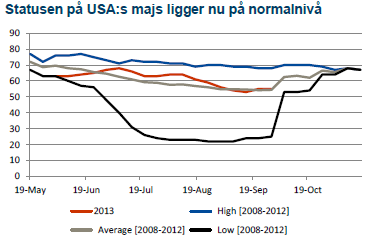 Sämre återhämtning i USA
Sämre återhämtning i USA
En ovanligt sen sådd av majs i USA och kallare än normalt väder under sommaren har hämmat utvecklingen av grödan. Förväntningarna på avkastning och antal skördade hektar har också fallit. Samtidigt har Brasilien levererat rekordskörd både på första och andra skörden. Den andra skörden går huvudsakligen på export och Brasilien konkurerar nu fullt ut med USA på exportmarknaden, vilket torde öka de domestika amerikanska lagren något detta år. Även i Ryssland har problemen tilltagit. Skörden är färdig men mycket regn har försenat sådden. Sen sådd ökar risken för skador under vintern och det är sammantaget naturligt att vetepriserna har stannat upp på en relativt hög nivå. Nu går vi över i en säsongsmässigt händelselös period och vi antar en mer neutral hållning för prisutvecklingen.
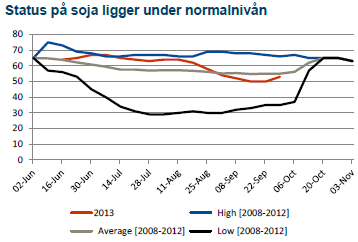 Sojalagren väntas förbli låga
Sojalagren väntas förbli låga
En gröda som sticker ut är sojabönor. Även här väntas skörden växa till rekordnivåer. Däremot väntas inte de utgående lagernivåerna förstärkas lika mycket. Kina gör idag anspråk på 75 % av exportmarknadens soja och den ekonomiska förstärkning i Kina som vi tror på de nästkommande 6 månader kommer bidra med en positiv impuls till sojaimporten.
[box]SHB Råvaruplanket är producerat av Handelsbanken och publiceras i samarbete och med tillstånd på Råvarumarknaden.se[/box]
Ansvarsbegränsning
Detta material är producerat av Svenska Handelsbanken AB (publ) i fortsättningen kallad Handelsbanken. De som arbetar med innehållet är inte analytiker och materialet är inte oberoende investeringsanalys. Innehållet är uteslutande avsett för kunder i Sverige. Syftet är att ge en allmän information till Handelsbankens kunder och utgör inte ett personligt investeringsråd eller en personlig rekommendation. Informationen ska inte ensamt utgöra underlag för investeringsbeslut. Kunder bör inhämta råd från sina rådgivare och basera sina investeringsbeslut utifrån egen erfarenhet.
Informationen i materialet kan ändras och också avvika från de åsikter som uttrycks i oberoende investeringsanalyser från Handelsbanken. Informationen grundar sig på allmänt tillgänglig information och är hämtad från källor som bedöms som tillförlitliga, men riktigheten kan inte garanteras och informationen kan vara ofullständig eller nedkortad. Ingen del av förslaget får reproduceras eller distribueras till någon annan person utan att Handelsbanken dessförinnan lämnat sitt skriftliga medgivande. Handelsbanken ansvarar inte för att materialet används på ett sätt som strider mot förbudet mot vidarebefordran eller offentliggörs i strid med bankens regler.
Analys
Tightening fundamentals – bullish inventories from DOE

The latest weekly report from the US DOE showed a substantial drawdown across key petroleum categories, adding more upside potential to the fundamental picture.

Commercial crude inventories (excl. SPR) fell by 5.8 million barrels, bringing total inventories down to 415.1 million barrels. Now sitting 11% below the five-year seasonal norm and placed in the lowest 2015-2022 range (see picture below).
Product inventories also tightened further last week. Gasoline inventories declined by 2.1 million barrels, with reductions seen in both finished gasoline and blending components. Current gasoline levels are about 3% below the five-year average for this time of year.
Among products, the most notable move came in diesel, where inventories dropped by almost 4.1 million barrels, deepening the deficit to around 20% below seasonal norms – continuing to underscore the persistent supply tightness in diesel markets.
The only area of inventory growth was in propane/propylene, which posted a significant 5.1-million-barrel build and now stands 9% above the five-year average.
Total commercial petroleum inventories (crude plus refined products) declined by 4.2 million barrels on the week, reinforcing the overall tightening of US crude and products.


Analys
Bombs to ”ceasefire” in hours – Brent below $70

A classic case of “buy the rumor, sell the news” played out in oil markets, as Brent crude has dropped sharply – down nearly USD 10 per barrel since yesterday evening – following Iran’s retaliatory strike on a U.S. air base in Qatar. The immediate reaction was: “That was it?” The strike followed a carefully calibrated, non-escalatory playbook, avoiding direct threats to energy infrastructure or disruption of shipping through the Strait of Hormuz – thus calming worst-case fears.

After Monday morning’s sharp spike to USD 81.4 per barrel, triggered by the U.S. bombing of Iranian nuclear facilities, oil prices drifted sideways in anticipation of a potential Iranian response. That response came with advance warning and caused limited physical damage. Early this morning, both the U.S. President and Iranian state media announced a ceasefire, effectively placing a lid on the immediate conflict risk – at least for now.
As a result, Brent crude has now fallen by a total of USD 12 from Monday’s peak, currently trading around USD 69 per barrel.
Looking beyond geopolitics, the market will now shift its focus to the upcoming OPEC+ meeting in early July. Saudi Arabia’s decision to increase output earlier this year – despite falling prices – has drawn renewed attention considering recent developments. Some suggest this was a response to U.S. pressure to offset potential Iranian supply losses.
However, consensus is that the move was driven more by internal OPEC+ dynamics. After years of curbing production to support prices, Riyadh had grown frustrated with quota-busting by several members (notably Kazakhstan). With Saudi Arabia cutting up to 2 million barrels per day – roughly 2% of global supply – returns were diminishing, and the risk of losing market share was rising. The production increase is widely seen as an effort to reassert leadership and restore discipline within the group.
That said, the FT recently stated that, the Saudis remain wary of past missteps. In 2018, Riyadh ramped up output at Trump’s request ahead of Iran sanctions, only to see prices collapse when the U.S. granted broad waivers – triggering oversupply. Officials have reportedly made it clear they don’t intend to repeat that mistake.
The recent visit by President Trump to Saudi Arabia, which included agreements on AI, defense, and nuclear cooperation, suggests a broader strategic alignment. This has fueled speculation about a quiet “pump-for-politics” deal behind recent production moves.
Looking ahead, oil prices have now retraced the entire rally sparked by the June 13 Israel–Iran escalation. This retreat provides more political and policy space for both the U.S. and Saudi Arabia. Specifically, it makes it easier for Riyadh to scale back its three recent production hikes of 411,000 barrels each, potentially returning to more moderate increases of 137,000 barrels for August and September.
In short: with no major loss of Iranian supply to the market, OPEC+ – led by Saudi Arabia – no longer needs to compensate for a disruption that hasn’t materialized, especially not to please the U.S. at the cost of its own market strategy. As the Saudis themselves have signaled, they are unlikely to repeat previous mistakes.
Conclusion: With Brent now in the high USD 60s, buying oil looks fundamentally justified. The geopolitical premium has deflated, but tensions between Israel and Iran remain unresolved – and the risk of missteps and renewed escalation still lingers. In fact, even this morning, reports have emerged of renewed missile fire despite the declared “truce.” The path forward may be calmer – but it is far from stable.
Analys
A muted price reaction. Market looks relaxed, but it is still on edge waiting for what Iran will do

Brent crossed the 80-line this morning but quickly fell back assigning limited probability for Iran choosing to close the Strait of Hormuz. Brent traded in a range of USD 70.56 – 79.04/b last week as the market fluctuated between ”Iran wants a deal” and ”US is about to attack Iran”. At the end of the week though, Donald Trump managed to convince markets (and probably also Iran) that he would make a decision within two weeks. I.e. no imminent attack. Previously when when he has talked about ”making a decision within two weeks” he has often ended up doing nothing in the end. The oil market relaxed as a result and the week ended at USD 77.01/b which is just USD 6/b above the year to date average of USD 71/b.

Brent jumped to USD 81.4/b this morning, the highest since mid-January, but then quickly fell back to a current price of USD 78.2/b which is only up 1.5% versus the close on Friday. As such the market is pricing a fairly low probability that Iran will actually close the Strait of Hormuz. Probably because it will hurt Iranian oil exports as well as the global oil market.
It was however all smoke and mirrors. Deception. The US attacked Iran on Saturday. The attack involved 125 warplanes, submarines and surface warships and 14 bunker buster bombs were dropped on Iranian nuclear sites including Fordow, Natanz and Isfahan. In response the Iranian Parliament voted in support of closing the Strait of Hormuz where some 17 mb of crude and products is transported to the global market every day plus significant volumes of LNG. This is however merely an advise to the Supreme leader Ayatollah Ali Khamenei and the Supreme National Security Council which sits with the final and actual decision.
No supply of oil is lost yet. It is about the risk of Iran closing the Strait of Hormuz or not. So far not a single drop of oil supply has been lost to the global market. The price at the moment is all about the assessed risk of loss of supply. Will Iran choose to choke of the Strait of Hormuz or not? That is the big question. It would be painful for US consumers, for Donald Trump’s voter base, for the global economy but also for Iran and its population which relies on oil exports and income from selling oil out of that Strait as well. As such it is not a no-brainer choice for Iran to close the Strait for oil exports. And looking at the il price this morning it is clear that the oil market doesn’t assign a very high probability of it happening. It is however probably well within the capability of Iran to close the Strait off with rockets, mines, air-drones and possibly sea-drones. Just look at how Ukraine has been able to control and damage the Russian Black Sea fleet.
What to do about the highly enriched uranium which has gone missing? While the US and Israel can celebrate their destruction of Iranian nuclear facilities they are also scratching their heads over what to do with the lost Iranian nuclear material. Iran had 408 kg of highly enriched uranium (IAEA). Almost weapons grade. Enough for some 10 nuclear warheads. It seems to have been transported out of Fordow before the attack this weekend.
The market is still on edge. USD 80-something/b seems sensible while we wait. The oil market reaction to this weekend’s events is very muted so far. The market is still on edge awaiting what Iran will do. Because Iran will do something. But what and when? An oil price of 80-something seems like a sensible level until something do happen.
-

 Nyheter4 veckor sedan
Nyheter4 veckor sedanStor uppsida i Lappland Guldprospekterings aktie enligt analys
-

 Nyheter4 veckor sedan
Nyheter4 veckor sedanSilverpriset släpar efter guldets utveckling, har mer uppsida
-

 Nyheter3 veckor sedan
Nyheter3 veckor sedanUppgången i oljepriset planade ut under helgen
-

 Nyheter3 veckor sedan
Nyheter3 veckor sedanLåga elpriser i sommar – men mellersta Sverige får en ökning
-

 Nyheter2 veckor sedan
Nyheter2 veckor sedanMahvie Minerals växlar spår – satsar fullt ut på guld
-

 Analys3 veckor sedan
Analys3 veckor sedanVery relaxed at USD 75/b. Risk barometer will likely fluctuate to higher levels with Brent into the 80ies or higher coming 2-3 weeks
-

 Nyheter1 vecka sedan
Nyheter1 vecka sedanOljan, guldet och marknadens oroande tystnad
-

 Nyheter1 vecka sedan
Nyheter1 vecka sedanJonas Lindvall är tillbaka med ett nytt oljebolag, Perthro, som ska börsnoteras



